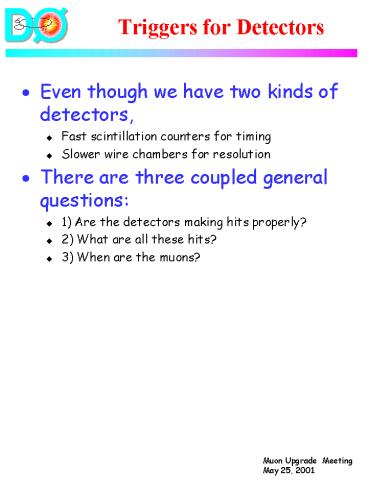Triggers for Detectors PowerPoint PPT Presentation
1 / 7
Title: Triggers for Detectors
1
Triggers for Detectors
- Even though we have two kinds of detectors,
- Fast scintillation counters for timing
- Slower wire chambers for resolution
- There are three coupled general questions
- 1) Are the detectors making hits properly?
- 2) What are all these hits?
- 3) When are the muons?
2
Scintillation Counters
- Timing Measurements for trigger ID
- Example A-Layer Background
- B/C-Layer Background gt 30 ns late
3
What are these hits?
- Hits are mostly background
- Goal to identify and suppress sources
(shielding?) - Once the B.D. starts making clean beam, including
scraping, we think the hits will come from
collisions. - Study minimum bias triggers
- We can easily test whether hits are noise and/or
cosmics (beam off). - We can test whether hits come from collisions or
from the tunnel. Procedure is - Take collisions record currents in wire chambers
- Separate the beam record currents in wire
chambers - Take collisions record currents in wire chambers
4
Proper Hits?
- How do we know if the detectors are making hits
properly? - Observed background features are sensible
- study trigger rate as a function of luminosity
- study time spectrum
- study position dependence
- Assuming 1 occupancy gt we need more than 100K
minimum bias triggers and some zero bias triggers
for comparison - That would provide an integrated time spectrum
and a notion of the position dependence. - Identified Muons show high hit efficiency
- Requires 1000 muons to determine if detectors
are generally working - a large sample to determine if individual
counters are working ( O100 muons per counter?)
5
When are the Muons?
- Requires actual muons
- Wed like to eventually tighten the trigger gates
so as to avoid triggering on background. - -2.58 sigma gate gt 99 effy
- Uncertainty in center of gate sn(-1/2)
- Uncertainty in sigma s(2n)(-1/2)
- If we want to position the gate to 0.2 ns and
sigma 5 ns, we need 625 muons per unit
detector, whatever that is. - Doesnt matter what kind of muons they are?
6
Old Rates
- Trigger list (10.6) shows
- Muon trigger
- Run 1 L1 26 hz/1030 in etalt1
- L1.5 0.7 hz/1030
- L3 5x10-3 hz/1030 including
best cal scint mutag _at_ pTgt15 GeV/c - Call it 5x10-2 hz/1030 for lower pT and wider
eta? - Muon Jet (1,5,etalt2) trigger
- Run 1 L1 1.5hz/1030 in etalt1
- L1.5 0.6 hz/1030
- L3 1x10-3 hz/1030 including
good cal scint _at_ pTgt15 GeV/c and
similarly high Et jet - Call it 5x10-2 hz/1030 for lower pT and wider
eta?
7
Summarize
- Get well on to understanding
- 1) Are the detectors making hits properly?
- 2) What are all these hits?
- May not go so far on
- 1) Are the detectors making hits properly?
- 3) When are the muons?
- Need 105 minimum bias triggers (more is better)
- Need more muons than we expect to get.
- In the long run we need Z-gtmu mu for calibration,
system efficiency.

